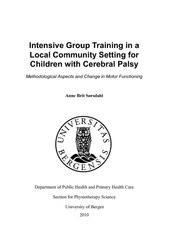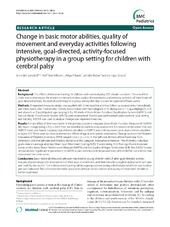| dc.contributor.author | Sørsdahl, Anne Brit | en_US |
| dc.date.accessioned | 2010-05-07T12:45:15Z | |
| dc.date.available | 2010-05-07T12:45:15Z | |
| dc.date.issued | 2010-02-18 | eng |
| dc.identifier.isbn | 978-82-308-0968-6 (print version) | en_US |
| dc.identifier.uri | https://hdl.handle.net/1956/3919 | |
| dc.description.abstract | The purpose of this thesis was to examine measurement properties of three outcome measures of motor function for children with cerebral palsy (CP), and to investigate change in their motor functioning following three weeks of intensive, activity-focused and goal-directed physiotherapy in a group setting. A portable electronic walkway has been found feasible and reliable when measuring gait parameters in adults with neurological disorders and in children with typical development, but measurement properties of the assessment tool have not been examined in children with CP. Test-retest reliability of gait parameters from the electronic walkway was investigated in 17 children with CP. A defined procedure to calculate speed dependent gait parameters at a normalised gait speed was used. In a short time span, the electronic walkway was found to be highly reliable for assessing gait parameters in children with CP. A subsequent study examined the inter-observer and intra-observer reliability of two quality of movement measures when scored from video clips. Quality of movement measures can be challenging and time consuming to score in a clinical setting due to the complexity of the construct. The impact of quality of movement on motor development has been sparsely investigated, but good quality is presumed by many professionals to increase efficiency and safety of activities and decrease efforts in children with CP. Hence an efficient way of assessing quality of movement seems important. Twenty-six children with CP participated in a reliability testing of the Gross Motor Performance Measure (GMPM) and the Quality of Upper Extremity Skills Test (QUEST). Performance of the test items were videotaped, edited and independently scored by two assessors on two occasions. The intra-observer and inter-observer reliability of the total scores of the two measures were found satisfactory, and the total scores can thus be recommended for research use. Reliability, however, was not satisfactory for the sub-scales and single items, and cannot be recommended for use as separate measures. The above three measures quantify different aspects of motor functioning in children with CP and were found to be reliable and feasible for use in clinical research, including research carried out as multicentre studies. There is little scientific knowledge about the optimal type, dosage and onset of physiotherapy for children with cerebral palsy. Recent work has indicated that more intensive, goal-directed and functional training than commonly offered by physiotherapists might be beneficial. Furthermore, there is little knowledge about the impact of movement quality on motor development in children with CP. The third study investigated change of motor functioning in children with CP who participated in intensive, activity-focused and goal-directed physiotherapy in a group setting for the first time. Twenty-two children aged three to nine years in five training groups from different places in Western Norway participated in the study. A repeated measures design was applied with three baseline measurements before and two follow up measurements after the intervention. The intervention aimed to attain individual goals regarding basic motor abilities and motor abilities in everyday activities, and consisted of three hours of physiotherapy, five days a week for a three-week period. After the intervention period, the children had gained significant improvements in basic motor abilities assessed by the Gross Motor Function Measure (GMFM) and high attainment of predetermined individual goals was found. The children’s parents reported significant improvement in the children’s ability to perform self-care activities in the home environments and a decreased need for caregiver assistance in mobility and self-care activities assessed by the Pediatric Evaluation of Disability Inventory (PEDI). A positive trend in improved quality of movement as measured by the Gross Motor Performance Measure (GMPM) and Quality of Upper Extremity Skills Test (QUEST) was revealed, but not statistically significant. A significant improvement in movement quality was found in items of the GMFM which improved during the study period, but not in items that reminded stable. Thus, acquisition of gross motor functions seemed to be related to better quality of movement, however, more research is needed to substantiate this observation. The intensive physiotherapy training in a group setting was experienced as fun and motivating, even though the children and their families also found the training period strenuous. Defined periods of intensive, focused training to attain specific goals seem to be a feasible way of optimising motor functioning in children with CP. | en_US |
| dc.language.iso | eng | eng |
| dc.publisher | The University of Bergen | eng |
| dc.relation.haspart | Paper I: Gait & Posture 27(1), Sorsdahl, A. B.; Moe-Nilssen, R.; Strand, L. I., Test–retest reliability of spatial and temporal gait parameters in children with cerebral palsy as measured by an electronic walkway, pp. 43-50. Copyright 2007 Elsevier. Full text not available in BORA due to publisher restrictions. The published version is available at: <a href="http://dx.doi.org/10.1016/j.gaitpost.2007.01.001" target="_blank"> http://dx.doi.org/10.1016/j.gaitpost.2007.01.001</a> | en_US |
| dc.relation.haspart | Paper II: Developmental Medicine and Child Neurology 50(2), Sorsdahl, A. B.; Moe-Nilssen, R.; Strand, L. I., Observer Reliability of the Gross Motor Performance Measure and the Quality of Upper Extremity Skill Test, based on Video Recordings, pp. 146-151. Copyright 2008 Blackwell Publishing. Full text not available in BORA due to publisher restrictions. The published version is available at: <a href="http://dx.doi.org/10.1111/j.1469-8749.2007.02023.x" target="_blank">http://dx.doi.org/10.1111/j.1469-8749.2007.02023.x</a> | en_US |
| dc.relation.haspart | Paper III: BMC Pediatrics 10(26), Sorsdahl, A. B.; Moe-Nilssen, R.; Kaale, H. K.; Rieber, J.; Strand, L. I., Change in basic motor abilities, quality of movement and everyday activities following intensive, goal-directed, activity-focused physiotherapy in a group setting for children with cerebral palsy. Copyright 2010 Sorsdahl et al., licensee BioMed Central. Reproduced with permission. Published version. The published version is also available at: <a href="http://dx.doi.org/10.1186/1471-2431-10-26" target="_blank"> http://dx.doi.org/10.1186/1471-2431-10-26</a> | en_US |
| dc.title | Intensive Group Training in a Local Community Setting for Children with Cerebral Palsy. Methodological Aspects and Change in Motor Functioning | en_US |
| dc.type | Doctoral thesis | |
| dc.rights.holder | Copyright the author. All rights reserved | |
| dc.rights.holder | The author | |
| dc.subject.nsi | VDP::Medisinske Fag: 700::Helsefag: 800::Fysioterapi: 807 | nob |


